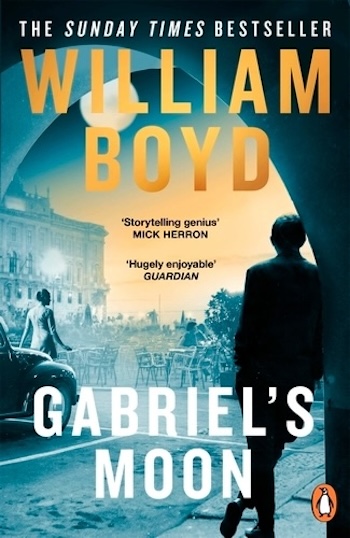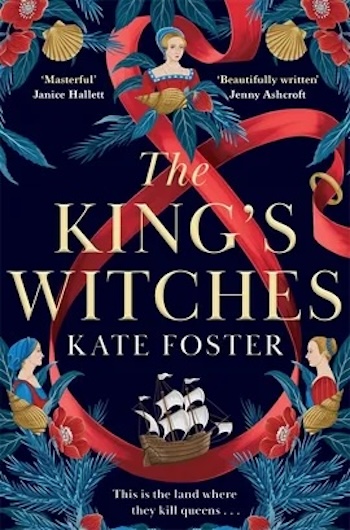Whether you’re braving airport queues, seeking shade in the garden, or sheltering from a sudden downpour, Philip Cottam’s eclectic summer reading selection offers something for every kind of escape: Cold War espionage with a reluctant hero, a chilling tale of witch hunts and royal intrigue, and a nostalgic return to one of England’s greatest sporting triumphs…
Gabriel’s Moon by William Boyd
Gabriel’s Moon is the eighteenth novel that William Boyd has written and sees him return to the murky world of espionage that he first entered with Restless (2006). Whereas the latter was set during the Second World War Gabriel’s Moon is set in the Cold War during the 1960s and charts the unexpected globe-trotting adventures of Gabriel Dax. Dax is a somewhat naïve travel writer, who gets ensnared by Faith Green, a fellow passenger on a flight back from an assignment in Africa, who just happens to be reading one of his travel books. Once Dax is back home she turns out to be a member of MI6. It does not take long for Dax to become a part-time operator – a floater – for MI6 starting with a seemingly straightforward job as a courier. Once on MI6’s books, Dax soon discovers that it is not easy to walk away especially as the money is not bad.
 Boyd is a well-practised story-teller who is able to combine a formidable depth of characterisation with complex and exciting plots and Gabriel’s Moon is no exception. Dax has an unusual back story with a family catastrophe in his childhood while at the same time he has to rise to the new challenges that result from his new career at MI6. It all begins, innocently enough, in the Congo at Brazzaville where he secures an interview with a paranoid and soon to be murdered Patrice Lumumba. It is this interview that brings the previously unimportant Dax to the attention of various intelligence services and his ensnarement by MI6. The adventures that follow take Dax to different parts of communist eastern Europe, including the playground for spies that was Cold War Berlin, as well as to Italy and Spain.
Boyd is a well-practised story-teller who is able to combine a formidable depth of characterisation with complex and exciting plots and Gabriel’s Moon is no exception. Dax has an unusual back story with a family catastrophe in his childhood while at the same time he has to rise to the new challenges that result from his new career at MI6. It all begins, innocently enough, in the Congo at Brazzaville where he secures an interview with a paranoid and soon to be murdered Patrice Lumumba. It is this interview that brings the previously unimportant Dax to the attention of various intelligence services and his ensnarement by MI6. The adventures that follow take Dax to different parts of communist eastern Europe, including the playground for spies that was Cold War Berlin, as well as to Italy and Spain.
The background against which Dax’s adventures take place is the 1960s – so think Cuba Missile Crisis, the heated atmosphere that involved anything to do with Berlin, the exposure and defection of Kim Philby and last but not least the unsavoury behaviour of almost everybody in central Africa. Boyd makes the most of it all and is particularly good at capturing the frequently fetid and often paranoid atmosphere that clung to anything involving espionage. Dax certainly gets infected by it while struggling with the domestic events that complicate his life still further.
Gabriel’s Moon is an enjoyable escapist romp though perhaps not quite as good as many of Boyd’s other novels and there were moments when it was in danger of becoming a bit of a caricature. That said, what it lacks in sophistication it certainly makes up for with energy and momentum. Dax is no Smiley – he is not intended to be – but following his adventures was a relaxing way to spend a rainy afternoon. By the way, for those who want to read more about Dax, he will reappear later this year in a follow-up novel The Predicament. I, for one, am looking forward to seeing how his career with MI6 develops and whether his domestic circumstances remain as chaotic including his problem with an infestation of mice.
Gabriel’s Moon by William Boyd is out now, published by Viking. For more information, visit www.penguin.co.uk.
The King’s Witches by Kate Foster
The King’s Witches is a retelling of the North Berwick witch trials and their connection with the marriage of James VI of Scotland to Princess Anne of Denmark written by the Edinburgh-based Scottish historical novelist Kate Foster. Her first novel The Maiden was a successful retelling of a 17th Century murder in a village, now subsumed by Edinburgh, involving two aristocrats. It won the Scottish Crime Debut of the Year in 2023 and was subsequently longlisted for the Women’s Prize for Fiction.
 The key relationship of The King’s Witches is that between King James and his soon-to-be wife. Having been forced, in Denmark, to watch the execution of a witch by burning, Anne is all too aware of – and appalled by – what happens to women accused and found guilty of witchcraft. Bad weather traps her ship in Norway for months and King James becomes so frustrated by the long wait that he eventually sets sail from Scotland to go and collect her himself. Already interested in witchcraft he becomes persuaded that this was the cause of the storms impeding his wife’s journey. And, once back in Edinburgh, and aware of a supposed plot by a witch in Berwick to overthrow him as well as prevent his marriage, he starts the pursuit of witches that results in the arrest of over seventy people, many of whom were tortured to extract confessions. The records are unclear how many were then executed.
The key relationship of The King’s Witches is that between King James and his soon-to-be wife. Having been forced, in Denmark, to watch the execution of a witch by burning, Anne is all too aware of – and appalled by – what happens to women accused and found guilty of witchcraft. Bad weather traps her ship in Norway for months and King James becomes so frustrated by the long wait that he eventually sets sail from Scotland to go and collect her himself. Already interested in witchcraft he becomes persuaded that this was the cause of the storms impeding his wife’s journey. And, once back in Edinburgh, and aware of a supposed plot by a witch in Berwick to overthrow him as well as prevent his marriage, he starts the pursuit of witches that results in the arrest of over seventy people, many of whom were tortured to extract confessions. The records are unclear how many were then executed.
Foster does take some liberties with the historical record to create the story she wants to tell. Her Princess Anne is seventeen years old rather than fourteen. The two other key female characters are fictional but realistic: there is Kirsten Sorenson, a Lady in Waiting for the Princess whose task is both to act as a chaperone as well as prepare her for the customs of the Scottish court; then there is Jura Craig, a poor servant girl from Berwick trying to make her way in the world. All three are affected by the witch-craze consuming the King, his court and the people of Berwick and Edinburgh. One of Foster’s strengths is her ability to recreate the atmosphere of paranoia created by the trials as well as the physical environment of late 16th Century Scotland and Edinburgh in particular.
Matters between the King and his bride don’t run smoothly either given the well-documented questions about his sexuality and Foster creates further confusion by introducing a handsome young tutor with whom the Princess falls in love. The King’s own obsession with witchcraft and its eradication which, in the real world, resulted in him writing a book about it creates an all-pervading atmosphere of fear. How the various connections between all the characters work out make for a good story and provide one or two twists for Foster to exploit. The book’s greatest strength, though, is how it exposes the misogyny and cruelty inflicted on the supposed witches – usually middle-aged or elderly and completely innocent women. That said, atmospheric, well-written and well worth a read though it is, it is not The Crucible and, for those wanting a purely historical perspective, I would recommend the late Hugh Trevor-Roper’s The European Witch-Craze of the 16th and 17th Centuries.
The King’s Witches by Kate Foster is published by Pan Books. For more information, please visit www.panmacmillan.com.
Victory in Australia: ‘The Remarkable Story of England’s Great Ashes Triumph 1954-55’ by Richard Whitehead
 With the current exciting test series with India still very much in the balance with all to play for and with the next Ashes series being held in Australia this coming winter it would be somewhat amiss not to include a book about a cricket tour. Richard Whitehead’s brilliantly written Victory in Australia, The Remarkable Story of England’s Great Ashes Triumph 1954-55 seemed appropriate as it records a remarkable triumph in the face of adversity down under by one of the best cricket teams ever to leave these shores. The captain was Len Hutton, the first professional to lead England, and his team included iconic figures such as Colin Cowdrey, Godfrey Evans, Peter May, Brian Statham and Alec Bedser. The 1954-55 victory was all the sweeter given it was twenty-two years since the previous time Australia had been defeated at home. In the seventy years since the victorious tour of 1954-55 this has only happened four more times. No wonder any victory down under is to be treasured.
With the current exciting test series with India still very much in the balance with all to play for and with the next Ashes series being held in Australia this coming winter it would be somewhat amiss not to include a book about a cricket tour. Richard Whitehead’s brilliantly written Victory in Australia, The Remarkable Story of England’s Great Ashes Triumph 1954-55 seemed appropriate as it records a remarkable triumph in the face of adversity down under by one of the best cricket teams ever to leave these shores. The captain was Len Hutton, the first professional to lead England, and his team included iconic figures such as Colin Cowdrey, Godfrey Evans, Peter May, Brian Statham and Alec Bedser. The 1954-55 victory was all the sweeter given it was twenty-two years since the previous time Australia had been defeated at home. In the seventy years since the victorious tour of 1954-55 this has only happened four more times. No wonder any victory down under is to be treasured.
The tour began inauspiciously with a devastating innings and 154 runs defeat at Brisbane. The 1911-12 series is the only other occasion when the English team has lost the first Ashes test in Australia and then gone on to win the series. The fight back started with a tight 38 run victory at Sydney largely as a result of the devastating fast bowling of Frank Tyson. Having gone for a miserable 160 runs for one wicket at Brisbane he took four wickets in Australia’s first innings and six in their second resulting in match figures of 10 wickets at a cost of 130 runs. It was the beginning of the legend of Typhoon Tyson. He went on to take a further 9 wickets for 95 runs in the Third Test, including a devastating 7 wickets for 27 runs in the Australian second innings, that gave England victory at Melbourne. In the Fourth Test at Adelaide where victory secured the series for England Tyson’s six wickets shared the honours with the other English bowlers. No victory was as decisive as the Australian victory in the first test because as Whitehead tells so eloquently it then became fiercely competitive throughout.
Just as there is more to the cricket than Tyson, although it was clearly a series dominated by the bowlers, there is more to Whitehead’s story than what happened on the pitch. He has produced a book that is also a social history of cricket at a time of change as it slowly became professional, although it took until 1962 for the distinction between amateur and professional to disappear. As for cricket tours they were much longer and more social than is the case today. The journey to Australia was by ship and took six weeks, the tour lasted over four months and the team played 23 matches including five six-day test matches. This is certainly a book for any sports fan, not just for cricket fans. It will also be of interest to anyone wanting to read about what a different world it was in the 1950s, social as much as sporting.
‘Victory in Australia: The Remarkable Story of England’s Great Ashes Triumph 1954-55’ by Richard Whitehead is out now in hardback and ebook, published by Bloomsbury. For more information, please visit www.bloomsbury.com.




